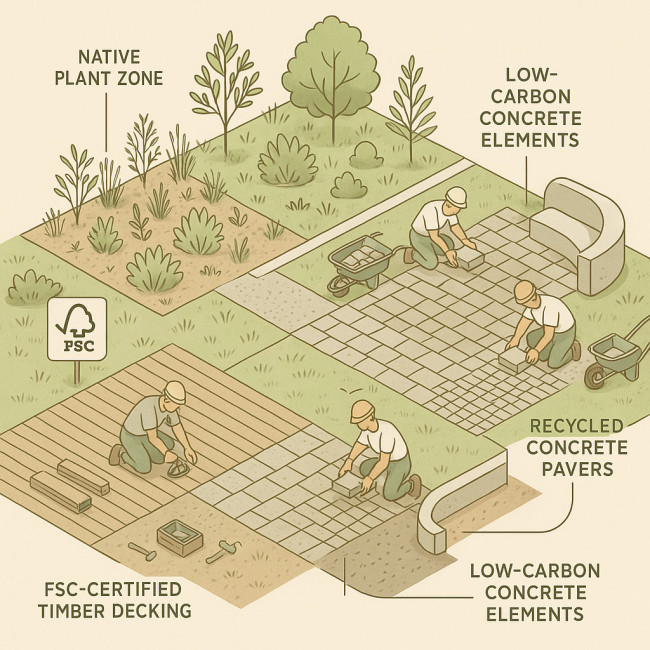Sustainable material sourcing for landscape projects: boost bid credibility
Need to win eco-minded tenders fast? Master sustainable material sourcing for landscape projects and you will back every design claim with hard evidence, ease permit approvals and score higher on bid evaluations.
Why sustainable sourcing elevates your landscape bid
Public authorities, corporate real-estate developers and hospitality brands now weight environmental impact at 25–45 % of their selection criteria. Demonstrating a sustainable material sourcing strategy signals risk-free compliance, long-term maintenance savings and positive PR. Bidders that attach carbon data sheets, third-party certificates and end-of-life plans consistently outperform aesthetic-only concepts.
Three credibility signals procurement teams scan first
- Lifecycle metrics: embodied carbon, recycled content and circularity pathways.
- Traceability documents: FSC, PEFC, EPD or cradle-to-cradle certificates.
- Community impact: local jobs, native species propagation and soil health markers.
Material categories that tick every sustainability box
Recycled aggregates & permeable bases
Swap virgin gravel for recycled concrete or glass cullet. Permeable bases reduce storm-water runoff and earn extra LEED or BREEAM credits.
Responsibly harvested timber
Specify FSC-certified hardwoods or thermally modified softwoods for decks and seating. These woods outlive pressure-treated pine by 10+ years, lowering total cost of ownership.
Low-carbon concrete alternatives
Geo-polymers, LC3 and fly-ash blends emit up to 70 % less CO2 per cubic metre. Pair them with eco-certified metal finishes for structural elements that meet circularity goals.
Native plant palettes
Sourcing from region-specific nurseries slashes transport emissions and eases maintenance. It also boosts biodiversity scores—vital when clients track urban biodiversity metrics.
Soil-safe additives
Avoid plastic geotextiles coated with harmful chemicals. Instead, consult the soil-safe materials list to pass restoration clauses without last-minute swaps.
Traceability paperwork: build a bullet-proof dossier
- Supplier declarations: signed letters detailing recycled content percentages.
- Third-party certificates: EPD, FSC chain-of-custody codes, CE marks.
- Transportation logs: proof of regional sourcing within 800 km to cut freight emissions.
- End-of-life plan: take-back agreements or reuse pathways.
Bundle the dossier as a single PDF and hyperlink it directly inside your digital bid portal—mirroring the intuitive layout used on leading spatial-designer profiles.
Cost-versus-impact cheat sheet
| Material | Average Cost €/m² | Embodied CO₂ kg/m² | Certification Available |
|---|---|---|---|
| Recycled concrete pavers | 28 | 16 | EPD |
| Geo-polymer concrete | 45 | 10 | EPD |
| FSC ash decking | 62 | 12 | FSC |
| Thermally modified pine | 48 | 18 | FSC |
| Bio-resin stabilised gravel | 34 | 8 | Cradle-to-Cradle |
Visualising carbon savings
Source : Building Transparency
Supplier-vetting workflow
- Initial screen: confirm certification and minimum five years of audit history.
- Site visit: inspect energy use, waste handling and worker welfare.
- Batch test: request lab reports for strength and contaminant levels.
- Contract clauses: late-delivery penalties and price adjustment triggers.
Integrate sustainability into design storytelling

Link each sourced material to a concrete performance benefit. For instance, a wetland boardwalk built with thermally modified ash can double as a learning trail on native hardwoods. Including animated 3D mock-ups—similar to the ones in our guide on GIS and drone mapping—helps evaluators picture the outcomes.
Common pitfalls and how to avoid them
- Greenwashing suppliers: cross-check certificates with registry databases.
- Inconsistent units: always convert data to kg CO₂ e per functional unit.
- Late substitutions: pre-approve alternates inside the contract to bypass costly change orders.
Interactive quiz: test your sourcing savvy
FAQ
- How many sustainable materials should I include in a bid?
- Prioritise the top five elements with the highest volume or visibility—pavers, structural timber, soils, planting and surfacing.
- Do recycled materials always cost more?
- No. Recycled aggregates and reclaimed bricks often cost 10–15 % less than virgin equivalents thanks to lower disposal fees.
- Can I phase sustainability improvements post-award?
- Yes, but specify milestones and price locks during negotiation to avoid disputes.
- What if a supplier loses certification mid-project?
- Insert a replacement clause requiring an equivalent or better certified source within 14 days.
Next steps: turn insights into winning bids
Download our sustainable sourcing plan template, adapt it to your next RFP and combine it with transparent pricing tiers as shown in our pricing guide for landscape designers. You will signal professionalism, de-risk execution and nudge evaluators toward that coveted top-three shortlist.
Ready to upgrade your sourcing pack? Book a strategy call and get personalised feedback within 48 hours.











